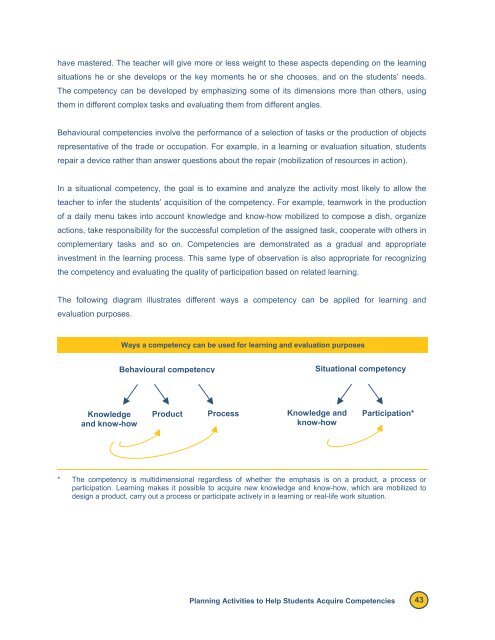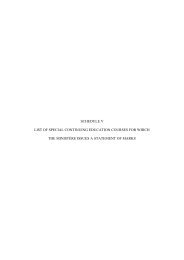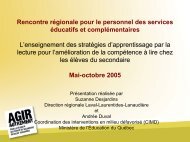Reference Framework for Planning Learning and Evaluation Activities
Reference Framework for Planning Learning and Evaluation Activities
Reference Framework for Planning Learning and Evaluation Activities
You also want an ePaper? Increase the reach of your titles
YUMPU automatically turns print PDFs into web optimized ePapers that Google loves.
have mastered. The teacher will give more or less weight to these aspects depending on the learning<br />
situations he or she develops or the key moments he or she chooses, <strong>and</strong> on the students’ needs.<br />
The competency can be developed by emphasizing some of its dimensions more than others, using<br />
them in different complex tasks <strong>and</strong> evaluating them from different angles.<br />
Behavioural competencies involve the per<strong>for</strong>mance of a selection of tasks or the production of objects<br />
representative of the trade or occupation. For example, in a learning or evaluation situation, students<br />
repair a device rather than answer questions about the repair (mobilization of resources in action).<br />
In a situational competency, the goal is to examine <strong>and</strong> analyze the activity most likely to allow the<br />
teacher to infer the students’ acquisition of the competency. For example, teamwork in the production<br />
of a daily menu takes into account knowledge <strong>and</strong> know-how mobilized to compose a dish, organize<br />
actions, take responsibility <strong>for</strong> the successful completion of the assigned task, cooperate with others in<br />
complementary tasks <strong>and</strong> so on. Competencies are demonstrated as a gradual <strong>and</strong> appropriate<br />
investment in the learning process. This same type of observation is also appropriate <strong>for</strong> recognizing<br />
the competency <strong>and</strong> evaluating the quality of participation based on related learning.<br />
The following diagram illustrates different ways a competency can be applied <strong>for</strong> learning <strong>and</strong><br />
evaluation purposes.<br />
Ways a competency can be used <strong>for</strong> learning <strong>and</strong> evaluation purposes<br />
Behavioural competency<br />
Situational competency<br />
Knowledge<br />
<strong>and</strong> know-how<br />
Product<br />
Process<br />
Knowledge <strong>and</strong><br />
know-how<br />
Participation*<br />
* The competency is multidimensional regardless of whether the emphasis is on a product, a process or<br />
participation. <strong>Learning</strong> makes it possible to acquire new knowledge <strong>and</strong> know-how, which are mobilized to<br />
design a product, carry out a process or participate actively in a learning or real-life work situation.<br />
<strong>Planning</strong> <strong>Activities</strong> to Help Students Acquire Competencies 43




